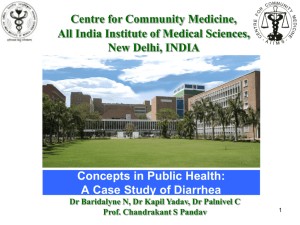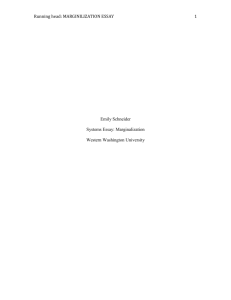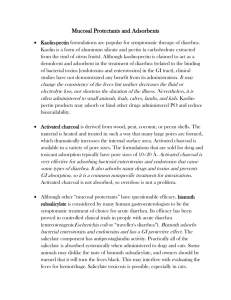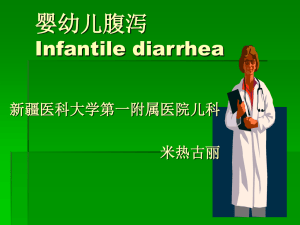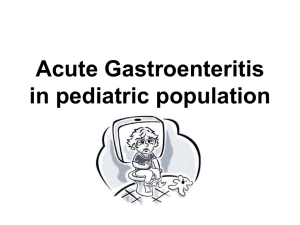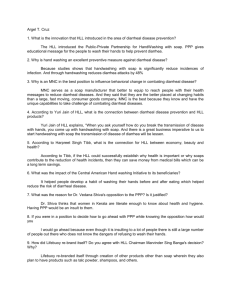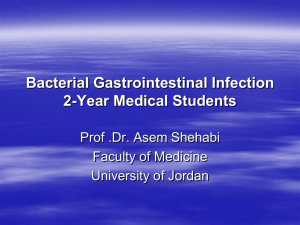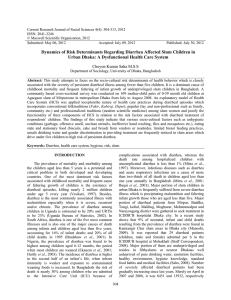common causes of diarrhea (1) - UCLA School of Public Health
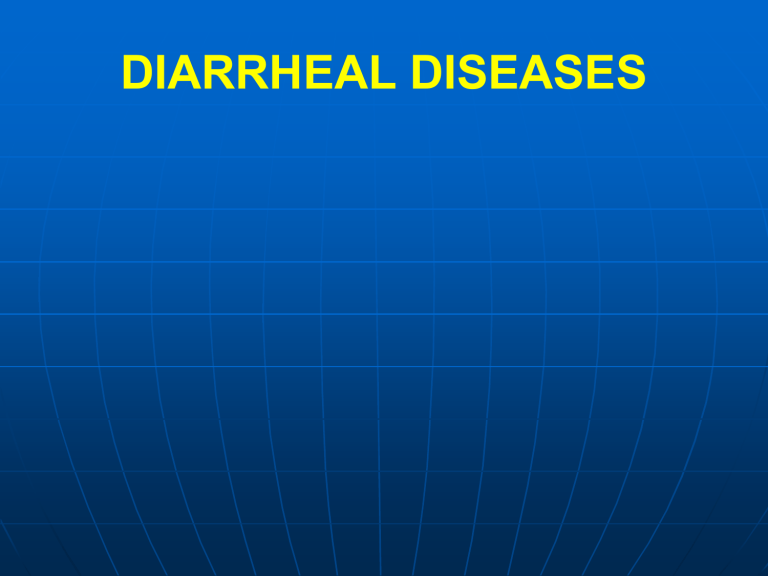
DIARRHEAL DISEASES
Top Ten Causes of Deaths in Low-Income Countries http://www.who.int/mediacentre/factsheets/fs310/en/index.html
Top Ten Causes of Deaths World-Wide http://www.who.int/mediacentre/factsheets/fs310/en/index.html
Importance of Diarrhea
According to the World Health
Organization, the incidence of diarrheal diseases (2,533 million cases) topped all other diseases in the Southeast Asian
(SEARO) and Western Pacific (WPRO) regions in 2004, accounting for 72.8 million disability-adjusted life years
(DALYS) - 4.8% of all DALYS worldwide due to both infectious and non-infectious diseases
Importance of Diarrheal Diseases
According to the World Health Organization in 2005,
1.8 million people died of diarrheal diseases, nearly
70% of whom were young children
Worldwide, diarrheal diseases are the third leading cause of mortality and morbidity (exceeded only by lower respiratory infections and cardiovascular diseases)
Globally there were 1.7 billion cases of diarrhea in
2013
Diarrhea is a leading cause of malnutrition in children younger than 5 years
WATER
TRUMPS
OIL
"Next to oxygen, water is indisputably the most precious resource we have, and the shortage of freshwater is the biggest long-term problem facing the planet Earth. Even energy is a distant second--with energy, we have alternatives. With water there are none."
Gil Grosvenor, chairman of the National Geographic
Society
World Water Day event focuses on growing thirst
. National Geographic 2010
The burden of thirst. National Geographic 2010
The burden of thirst. National Geographic 2010
Water Sources and Usage
Nearly 97% of the planet's water is salt water in seas and oceans
Close to 2% of Earth's water is frozen in polar ice sheets and glaciers
Only a fraction of 1% is available for drinking, irrigation, and industrial use
Agriculture accounts for 70% of all water use
Lack of Clean Water and Safe Waste
Disposal
The average American uses a hundred gallons of water at home every day
In developing countries, nearly one billion people worldwide have no access to clean water
2.5 billion people (40% of world’s population) have no safe way to dispose of human waste
Dirty Water and Lack of Hygiene
Dirty water and lack of a toilet and proper hygiene kill 3.3 million people around the world annually, most of them children under age five
Reasons for Lack of Clean Water
Climate (drought, deforestation, climate changes) and dropping water tables worldwide
(unsustainable rate of water use)
Poverty (inability to build wells or to afford piped water or water purification tablets if available)
Rural dwellers- remote, sparsely populated, drought-stricken villages of the world are least likely to be reached for water provision, education, etc.
Pollution
Steps to Reduce Waterborne
Diseases
• Safe disposal of human waste (latrines)
• Hand washing
• Education about sanitation
• Piped, treated water
• Food safety
Clasen T, Sugden S. Water and sanitation. Oxford Textbook of Public Health, 5 th ed. Oxford Press, England.
Politics of Water
The United Nation's General Assembly voted to make water a basic human right. But 41 countries, including the United States , opted out, saying they were waiting for more data!
Characteristics of Diarrheal Diseases
Oral-fecal route of infection (contaminated water and food)
Leads to rapid dehydration and inability to absorb nutrients from food; survivors may have impaired growth and development, malnutrition, long-term GI disorders, reduced immunity
Diarrhea Incidence
COMMON CAUSES OF DIARRHEA (1)
Bacteria
• Escherichia coli
• Salmonella (S. typhii, etc.)
• Shigella (S. flexinari , dysenteria, sonnei, etc.)
• Campylobacter
• Vibrio cholerae
COMMON CAUSES OF DIARRHEA (2)
Viruses
• Rotavirus
Protozoa
• Giardia lamblia
• Cryptosporidium parvum
• Entamoeba histolytica
• Cyclospora cayetanensis
IMPACT OF DIARRHEAL AGENTS ON GUT
Directly pathogenic organism
Production of toxin by specific organisms
Disruption of gut mucosa and gut function
Overcome commensal (good) gut organisms
Inflammation of gut mucosa
TRANSMISSION ROUTES
Direct: fecal-oral
Indirect:
Water (e.g. V. cholerae , Norwalk virus)
Food (e.g., salmonella, campylobacter, E. coli , O157:H7)
Eating utensils (e.g., baby bottles, nipples, cups, spoons)
Animals (e.g., C. jejuni , C. perfringens , E. coli , O157:H7)
Flies (carrier, ingested – Shigella)
Poor hygiene (inadequate/infrequent hand washing and non-hygienic feces disposal
Promiscuous drug use – overtreatment of humans and antibiotics in animal feed promotes drug resistance
HOST RISK FACTORS FOR DIARRHEA
Malnutrition (up to 70% increased risk)
Micronutrient deficiency (e.g. vitamin A and zinc)
Low gastric acid/hypochlorhydria (H. pylori)
Reduced gastric acid acidity (e.g. associated with some medications)
Compromised cell-mediated immune capacity/response
Genetic profile (e.g., blood group O increases susceptibility to V. cholerae)
COMMUNITY STRATEGIES TO
REDUCE DIARRHEA
Promotion of breast feeding and better weaning practices
Safe water provision and waste disposal
Promotion of hand washing
Measles vaccination
Cholera vaccination in high risk areas
Zinc and vitamin A supplementation
Rotavirus vaccination: Rota Teq,
Rotarix
Prevention of Diarrheal Diseases
Provision of accessible clean water
Safe disposal of waste (sanitation)
Education of mothers
Making home treatment and storage of water inexpensive and feasible
Provision of latrines
Promotion of hand-washing and personal hygiene
Reduce fly population
Promotion of breastfeeding and proper weaning
POLITICAL WILL
MONEY
TREATMENT OF ACUTE DIARRHEA
Oral rehydration
Appropriate energy (food) intake
Zinc supplementation for 10-14 days
Referral to health facility if not improving on above regimen
Antibiotics (dysentery, typhoid fever, cholera only)
Intravenous saline (severe cases only)
